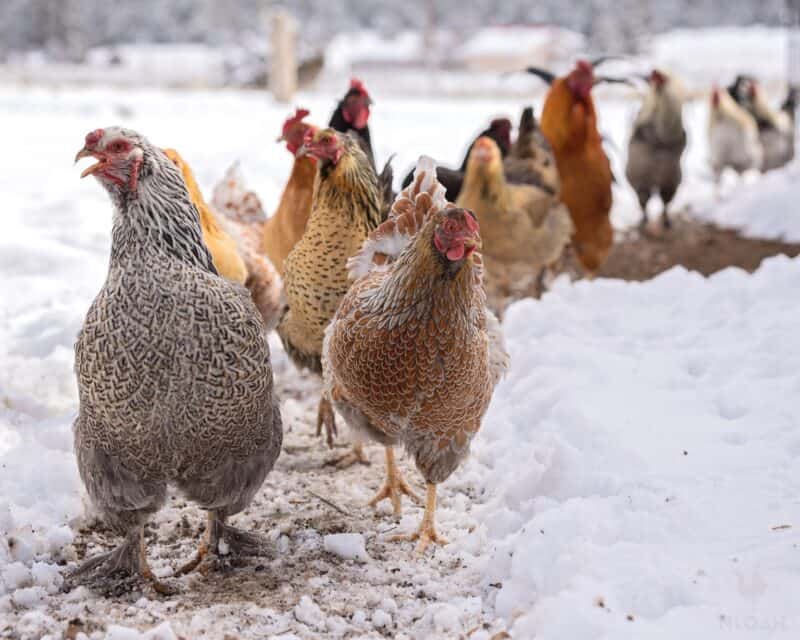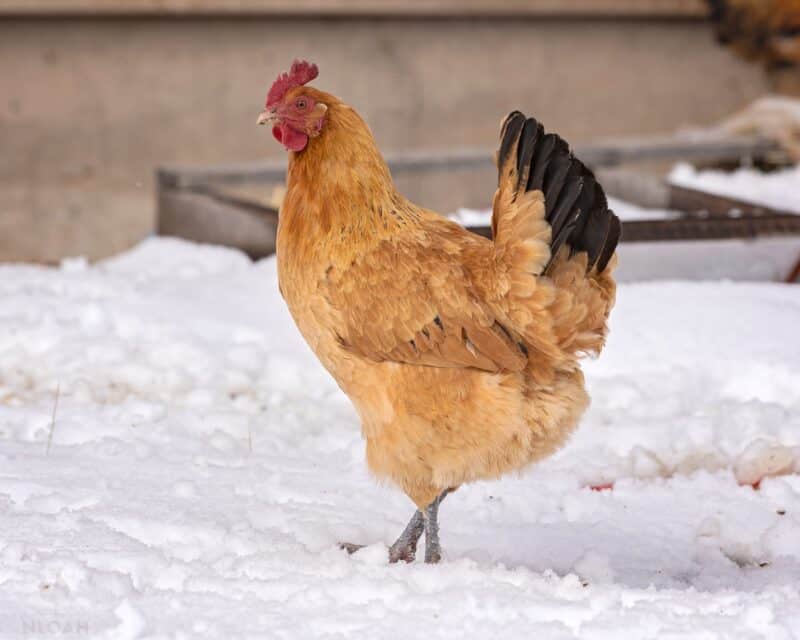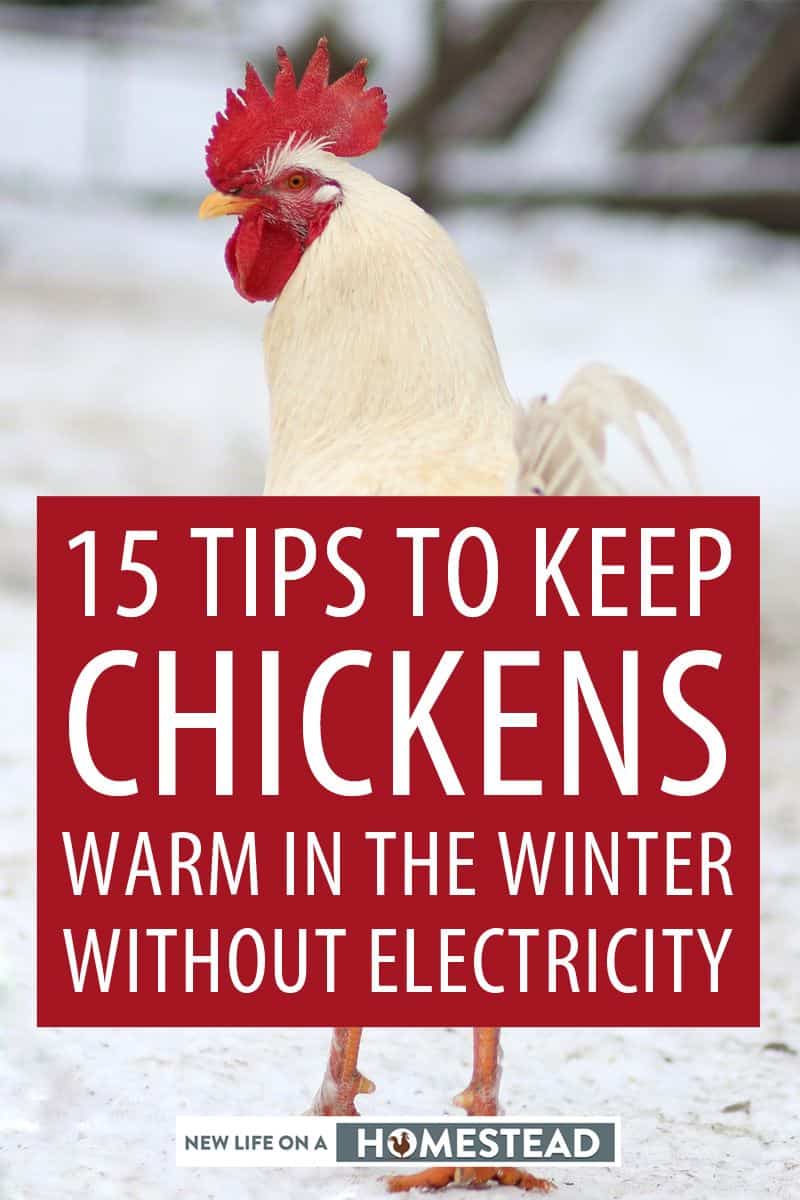If you’re wondering how to keep chickens warm in the winter without electricity, you’ve come to the right place – and I have a secret to tell you… For the most part, chickens can handle the cold weather themselves. They don’t need you.
I know, that might break your heart. To some extent, you want your chickens to rely on you – you want them to need you and want you around, right?

Unfortunately (or fortunately?) that’s not the case. Chickens can really take care of themselves in the winter, and do best with as little interference on your part as possible.
I’m frequently asked by friends and neighbors why we don’t use a heater in our chicken coop in the winter. It regularly gets to negative temperatures in the winter, usually accompanied by heavy snowfall and blustery winds – resulting in a nasty wind chill.
Nevertheless, we have never heated our chicken coop and don’t plan to. We rarely have to worry about frostbite and have never lost a chicken to the cold weather.
Here are some tips on how to keep your chickens warm in the winter without electricity – it’s easier to do than you might think!
Do a Thorough Coop Inspection
Before winter truly sets in, it’s a good habit to inspect your coop and do a good ol fashioned deep clean. Take out all the bedding, and disinfect everything.
Then, do a thorough inspection. Are there any gaps, holes, or cracks in the walls that could let in cold air? Even worse, some large gaps can let in opportunistic predators like weasels and rats?
If there are, seal up all of those cracks, gaps, and holes. It’s especially important that you get rid of any cracks or gaps around the roost bars, where your chickens are most susceptible to chilling breezes.
Remember, as you are doing your inspection, that drafts are not the same thing as ventilation. Drafts are cold and piercing, while ventilation will filter the moist air out of the coop and bring in fresh, dry air.
This is absolutely essential. A chicken coop that is poorly ventilated (or too well-insulated) will cause more problems than one is too drafty.
Chickens produce a lot of moisture as they breathe and defecate. That moisture needs to leave someone. Truly, your worst enemy in cold weather isn’t actually the cold, but instead the moisture, as it can cause frostbite.
Make sure your coop is designed with plenty of ventilation (ideally, some louvers or other mechanisms near the top) so you can get rid of that moist, dangerous air.
Relocate or Redesign Your Coop if Possible
Carefully consider the location of your coop. Where your coop is positioned can really affect how easy it is to keep them warm. If you’re able to move your coop, put it in a protected area where the driving winds won’t slice right through.
You may want to redesign your coop, too. You can make it smaller by closing off a portion with boards. This is a great hack if your coop is extremely large and has more space than you actually need. Your ceiling should be about two feet from the roosting bars to help heat stay in the coop.
Put Down Plenty of Bedding
Once your coop is clean and sealed, it’s time to re-bed it. Make sure you have a solid layer of bedding down in the coop, ideally a warming bedding like straw, sawdust, wood chips, or wood shavings.. You can also use shredded newspapers.
A good foot or two is necessary, particularly if you live in a cold climate or if your coop has a dirt floor.
Chickens don’t have feathered feet, for the most part (though some have feathered legs) so being on cold, hard ground can be harmful. A thick layer of bedding will keep them nice and cozy – and warm!
You can also implement the deep litter method of bedding in the winter. This method of bedding requires adding more bedding each week but not removing the old. Essentially, the old bedding will begin to compost, generating heat as it does so.
This will not only help the chickens stay warm but it will reduce your weekly chores – less manure to move! You can clean it out in the spring and use it in your compost or garden.
Add Some Bales to the Coop
You can add a few straw bales inside the coop. Put these near the doors to help block off drafts. Your chickens can roost on top and share body heat to stay warm, and you can always use the bales in your garden come springtime.
Invest in Good Roosts
As long as you have adequate roosts, your chickens will stay nice and warm all night long. You need to have a roost that is at least two inches wide so your chickens can sit completely to cover their legs and feet. Make sure your chickens have plenty of room to roost together, and stay warm.
Add Some Good Insulation
Good insulation is key to maintaining the warmth inside the coop. There are many options that you can choose from, but a common option is foam – specifically foam boards. They’re easy enough to find and install; they also help to keep the cold out of the coop. Other good options are old carpet and/or flattened cardboard boxes.
Plastic sheets and pieces of plywood will also work.
Cover Up your Coops in Winter
Another way to keep chickens warm without electricity is to cover the outside of the coops with fabric, blankets, and/or tarps. This helps keep the warmth in and the cold draughts out of the coop.
Employ the Power of Sunlight
Don’t neglect the power of Mother Nature when you’re designing your coop! You can use sunlight to help capture heat and keep the coop warmer. Use a few well-insulated windows to trap the sun. Layers of clear plastic can help produce a greenhouse effect, too.
You can also increase the amount of thermal mass in your coop. The more it has, the more steadily it will release heat. You will want to use things like a compost floor, concrete, or even stone to help retain heat during the day and slowly release it overnight.
Don’t Hold Back the Feed
I’ve always been an advocate of auto-feeders, and that’s especially true in the winter. Eating and digesting will help warm your chickens up, so you should never let them run out.
Chickens naturally want to consume more food in the winter. Trying to stay warm is hard work, and it burns a lot more calories than your chickens might burn in the summer, even if they are locked up in the chicken coop.
Plus, if there’s snow cover, there isn’t any grass, vegetation, or bugs they can eat – they don’t have any other way to supplement their diet.
Feed Treats or Scratch at Night
Night is going to be the coldest time for your chickens – especially if you’re living in places like Alaska or Canada where the winters can be particularly rough.
You can encourage the digestive process by sprinkling a bit of scratch grain or providing some other treats (warm oatmeal is a great option) just before your chickens go to bed. Do this when you head out to lock them in at night.
You shouldn’t have to worry about them overdoing it on the treats, either, since they’ll already have done most of their eating for the day.
Manage the Snow Load
You will need to exert some effort when it comes to managing snow load around your chicken coop and run.
Start by shoveling out an area of the coop and then you can lay some hay, straw, or other warm bedding down for your chickens to walk on. Alternatively, you can sprinkle scratch to encourage the chickens to come out.
A bit of fresh air is great for your chickens in the winter, and after a while, they’ll get used to coming out on their own.
If snow doesn’t slide right off your chicken coop, you may need to remove it with a rake – but don’t stress if there’s a bit of snow on top. It can have an insulating effect. As long as your roof is secure and sturdy enough to handle it, you can leave it be.
Make a Sunroom
If your chickens are really reluctant to go outside in cold weather, consider making them a sunroom. You can do this by building a greenhouse-style addition to the coop simply by covering a section with clear plastic. Your chickens will still be able to go outside and get some fresh air, but without the chill!

Guard Against Frostbite
The real threat to your chickens’ health and wellbeing in the winter is frostbite. This is particularly true if you have chickens with large wattles or combs. Cover the combs in petroleum jelly to help ward off the chill.
Thoroughly Bed the Nest Boxes
You can’t always prevent eggs from freezing in the winter, but there are a few steps you can take to reduce the likelihood of it occurring.
For starters, make sure your nesting boxes are always filled with fresh, clean bedding. If you notice any cracks in your eggs or frozen spots, discard them. If the egg froze but did not crack, you can put it in the fridge and allow it to thaw slowly before consuming it.
Otherwise, prevent frozen eggs by collecting them as often as possible. This will help you prevent any potential for foodborne illness.
Mind the Water
Keeping chickens warm in the winter without electricity is not a challenge – keeping the water fresh and preventing it from freezing, however, is.
The water is going to freeze at some point during the day, and honestly, your best bet is a heated waterer – but this requires electricity. To prevent your water from freezing, you have a few options.
You can provide a rubber feeder filled with fresh, fluffy snow, so your chickens can peck at that as they please. Then, each morning and evening, add water. You can use a saltwater bottle inside a water dish to help prevent the water from freezing, too, but this only works in temperatures that are just below freezing.
Don’t Put Out Young Chicks
If you’re chomping at the bit to get your chicks outside, wait until they are fully feathered. Ideally, you shouldn’t be introducing new chicks to the coop in the winter or early spring. Wait until the weather is warm, or your chicks will become chilled.
Consider Your Breed
Although most chickens do just fine in cold weather – even without electricity – there are some that thrive much more than others. Those that are larger with small combs do best, while those that are thin, flighty, or large-combed suffer more.
Some of the best cold-hardy chicken breeds include:
- Australorps
- Rhode Island Red
- New Hampshire Red
- Speckled Sussex
- Delaware
- Cochin
- Brahma
- Buff Orpington
- Wyandotte
Electricity Isn’t Needed to Keep Chickens Warm
Lots of chicken keepers will advise using a heater to keep the coop warm – I do not recommend it, even in the coldest of climates.
Here’s why.
Think of the shock that you experience – no matter how temporary – when you first step out of a nice, warm house into a cold, blustery winter day. It feels awful, right?
Studies show that this sharp contrast can also lower your body’s immune response, and make it harder for you to stay warm, versus if you were staying outside for prolonged periods of time.
The same thing happens with chickens. If chickens get used to the nice, warm temperatures of the coop, and then a power outage shuts off that heat supply unexpectedly, what are you going to do? The chickens won’t adjust well.
Therefore, don’t stress about the fact that you don’t have electricity in your chicken coop for the winter months. It’s not only unnecessary but ill-advised. Your chickens will stay plenty warm enough on their own.
There are certainly solar heaters you can buy if you are absolutely panicked about keeping your chickens with a heater, but I really don’t think they are necessary.
Follow these tips for keeping your chickens warm in the winter without electricity, and you’ll be able to get them through tops print with no problems at all.


Rebekah is a high-school English teacher n New York, where she lives on a 22 acre homestead. She raises and grows chickens, bees, and veggies such as zucchini (among other things).
